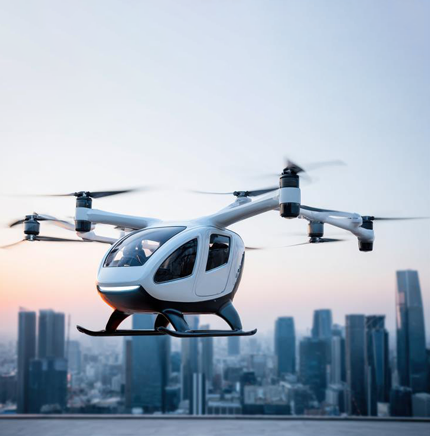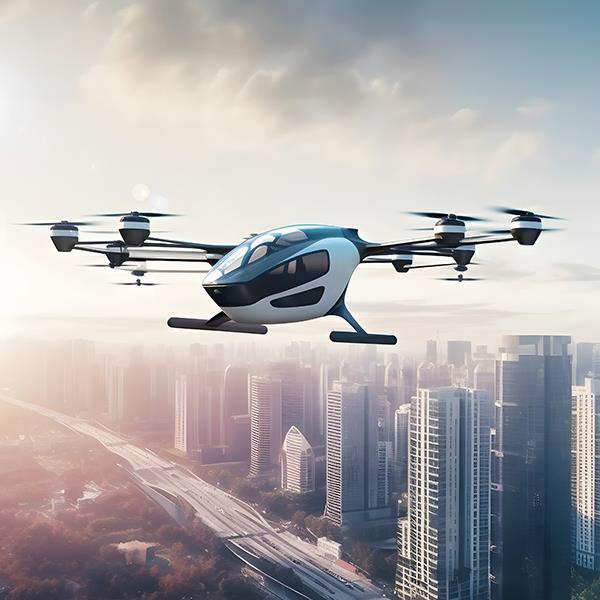

Blog
The Future of eVTOL: Analyzing Technical Challenges and their Contributions to the Mobility Ecosystem
Exploring how eVTOL aircraft, powered by AI and advanced technology, are reshaping urban air mobility—applications, challenges, and the road ahead.
Navigation
NavigationExecutive Summary
Electric Vertical Takeoff and Landing (eVTOL) aircraft are emerging as intelligent aerial platforms that combine mobility with advanced capabilities—enabling real-time intelligence, surveillance, and rapid response. From air taxis reducing urban congestion to emergency medical services, logistics, and defense, these next-generation aerial vehicles promise cleaner, safer, and more connected mobility solutions. This blog examines what makes eVTOLs the future of mobility, explores their most promising use cases, highlights how emerging technologies are accelerating adoption, and analyzes the technical challenges that must be addressed for large-scale deployment.
What Makes eVTOLs the Future of Mobility?
Imagine a future where aerial mobility is the norm. With the rapid advancement of Electric Vertical Takeoff and Landing (eVTOL) technology, flying cars will be cutting through the skies one day, offering a quieter, cleaner, and potentially safer alternative to helicopters and airplanes. The eVTOL aircraft are poised to revolutionise urban transportation with their ability to take off and land vertically. These aircraft offer a promising solution to traffic congestion and emissions. The future of eVTOL promises to take flight in a multitude of ways, from revolutionising delivery services with autonomous package carriers to becoming intelligent assistants that complete tasks in hazardous or hard-to-reach environments.
The size of the worldwide Urban Air Mobility (UAM) market is USD 64.32 billion in 2025, and it is expected to increase at a compound annual growth rate (CAGR) of 14.5% from 2026 to 2030. Many factors are fueling this growth, including rapid technological advancements, a widening range of applications across industries, the expertise of specialized engineering partners, and the steady decline in eVTOL technology costs.
What Are the Key Use Cases for eVTOLs?

Potential Use Cases for eVTOLs
As eVTOLS continues to advance, Urban Air Mobility (UAM) is emerging as a promising solution to reduce ground traffic congestion. One of the most notable eVTOL applications is its role as the next technological step in ridesharing, with leading manufacturers investing heavily in a future where commuters bypass traffic through on-demand aerial mobility. Airport shuttle services are considered one of the most promising early use cases for UAM, facilitating seamless connections between airports and key city areas such as downtown, ports, and resort zones. Innovative startups are also proposing Sky Bus concepts to address large-scale passenger transit with eVTOLs, initially through manned services and eventually transitioning to autonomous operations.
eVTOLs will transform tourism by overcoming geographical limitations, providing access to remote destinations like islands, mountains, and forests, requiring only a GPS location and a flat landing spot. Switching to eVTOLs would be a cheaper option, and the quiet operation enhances the passenger experience, ensuring serene journeys. While the development of charging infrastructure and vertiports is crucial, the transformative potential of eVTOLs in tourism outweighs any logistical challenges.
While the most widely known use of eVTOLs is in passenger transport, this is not the only application in development. Using eVTOLs for roles in agriculture, logistics, and emergency medical services will involve the same fundamental concepts as passenger aircraft but are arguably more realistic and achievable visions based on current regulations and technology. With their ability to navigate diverse landscapes and quickly deliver payloads, they offer a compelling solution to the evolving demands of the global supply chain. Key players in the cargo industry are exploring various eVTOL designs and technologies to meet the needs of the growing e-commerce business landscape.
Global players are aiming to and are also working on utilising eVTOLs in crop farming. These fully autonomous aircraft can collect data during routine checks to protect crops from various threats. This includes tasks such as moisture and fertiliser monitoring, as well as crop dusting, with the potential to significantly enhance overall farm efficiency. The concept is straightforward: automate many of the time-consuming and error-prone agricultural processes using drones. For instance, traditional crop dusting involves applying pesticides across the entire field, which is both time-consuming and wasteful. By employing eVTOL technology, farmers can precisely target specific areas affected by pests, minimising the impact on the rest of the field. In parallel, weather-monitoring drones are emerging as critical tools for atmospheric data collection, helping predict storms, track climate patterns, and support disaster preparedness.
eVTOLs also show great potential in emergency medical response, enabling rapid deployment in critical situations to facilitate quick aerial commutes through congested urban areas to accident sites or hospitals, presenting a compelling value proposition. Unlike conventional helicopters, eVTOLs can take off and land vertically in minimal space, making them ideal for rugged and unpredictable terrain. This capability allows rescue teams to reach victims quickly, even in the most challenging environments, without the need for extensive infrastructure. Additionally, eVTOLs can be equipped with advanced sensors and imaging technologies, such as LiDAR and thermal imaging cameras, enabling rescuers to locate individuals in difficult-to-see areas like dense forests or snowy slopes. By providing real-time data, eVTOLs help pinpoint the exact location of those in need, significantly reducing rescue operation times.
In law enforcement, eVTOLs offer a future of enhanced situational awareness and preparedness for potential crimes or threats. They provide airborne Intelligence, Surveillance, Target Acquisition, and Reconnaissance (ISTAR) capabilities, ideal for fully autonomous, multi-sensor, and highly covert operations. These aerial vehicles are also suitable for a wide range of military applications, including reconnaissance, transportation, and logistics. The high-speed and long-range capabilities of some eVTOL designs make them perfect for rapid deployment of troops and equipment in remote or hard-to-access locations.
What Are the Biggest Technical Challenges in eVTOLs Development?
The development of eVTOL aircraft presents a complex array of technical challenges, including:
Battery Management
One of the primary challenges in eVTOL development is the current limitations of battery technology. Despite the flexibility and efficiency offered by electric motors, the power-to-weight ratio of existing batteries falls short of the requirements for sustained flight. This necessitates carrying a significant amount of battery weight, which directly impacts payload capacity and range. While electric motors offer superior mechanical efficiency compared to internal combustion engines, the overall power-to-weight efficiency of turbine engines remains significantly higher. Additionally, the weight of batteries remains constant throughout their discharge cycle, limiting flexibility in terms of fuel, range, and payload. This necessitates innovative solutions such as modular battery systems for quick changes.
Power Efficiency
During takeoff and landing, peak power output can stress propulsion systems and batteries, requiring effective heat management and durability. Optimising cruise power efficiency, which is lower than maximum power, is also crucial for maximising range and endurance. This involves designing efficient propulsion systems and aerodynamic optimised airframes.
Motor Weight Optimization
eVTOLs require a multitude of electric motors for propulsion, wing movement, and flight control. These motors must be compact, lightweight, and powerful to avoid compromising the aircraft's aerodynamic design and performance. The development of frameless motors with high torque density is crucial to meet these stringent requirements.
Autonomous Flight and Safety
The transition to autonomous flight in eVTOLs requires developing reliable control systems for safe and efficient autonomous operation. Furthermore, establishing protocols for beyond-visual-line-of-sight communications and integrating eVTOLs into existing air traffic management systems are essential to ensure safety and prevent collisions.
Noise Reduction and Environmental Impact
While eVTOLs offer a significant reduction in engine noise compared to conventional aircraft, aerodynamic factors contribute substantially to overall noise levels. Mitigating noise pollution and minimizing the environmental impact of eVTOL operations remains a crucial area of focus.
Infrastructure Development
The widespread adoption of eVTOLs will require the development of specialised infrastructure, including vertiports. These facilities must be designed to withstand the downwash generated by multiple rotors and ensure the safety of passengers, goods, and ground personnel. Additionally, regulations and protocols need to be established for ground operations and traffic management at vertiports. Fast charging is a critical aspect of eVTOL operations, enabling operators to maximise vehicle uptime and revenue generation. Establishing a robust charging infrastructure with significant investment in grid upgrades and renewable energy integration is critical to support the high-power demands of fast charging.
Deployment of UAVs in adverse weather conditions
Weather conditions significantly impact the performance and operational efficiency of UAVs. Ambient temperatures can accelerate battery degradation, leading to reduced flight time and increased charging frequency. Additionally, extreme temperatures can strain propulsion systems and affect charging times. In cold weather, lower efficiencies and increased internal resistance can slow down the charging process. Inclement weather conditions also pose challenges like unwanted deviations from planned trajectories and potential safety risks that hinder the effective use of UAVs. Factors like operation time, path elevation, altitude, and flight direction can be significantly affected by such atmospheric conditions.
How are Emerging Technologies Accelerating eVTOL Adoption?
The convergence of new age technologies such as artificial intelligence, electrification, autonomous systems, advanced materials, and next-generation connectivity is accelerating the adoption of eVTOLs by addressing long-standing operational and safety challenges. AI enhances situational awareness by interpreting complex data streams and adjusting flight performance in real time—optimizing paths, monitoring system health, and adapting telemetry to terrain and air traffic conditions. Electrification, enabled by advances in battery chemistry and high-efficiency motor design, improves power density and thermal management, which are critical for sustained operations. Autonomous systems strengthen reliability by minimizing human error and enabling beyond-visual-line-of-sight operations, ensuring predictable and scalable performance. Meanwhile, advanced materials and metallurgy contribute lighter yet stronger structures, directly impacting payload capacity and endurance, while 5G and edge computing enhance vehicle-to-infrastructure communication for seamless traffic integration. Together, these technologies transform eVTOLs from conceptual prototypes into scalable, practical solutions for next-generation air mobility.
Conclusion
Despite existing challenges, eVTOLs stand as the next frontier in advanced mobility—delivering tangible benefits in sustainability, safety, and efficiency. While long-term applications such as large-scale air taxi networks may take time to mature, immediate opportunities are already within reach. Cargo logistics, precision agriculture, and emergency medical services provide realistic, high-impact entry points where eVTOLs can demonstrate value today.
While economic considerations, safety validations, and regulatory frameworks remain critical, these are not insurmountable barriers. These can be progressively addressed through a combination of advanced technologies—such as AI-driven autonomy, smart materials, cloud connectivity and predictive analytics—and a collaborative development model. By working closely with specialised engineering partners, OEMs can share risk, accelerate innovation, and ensure that solutions are robust, scalable, and compliant with evolving standards.
The eVTOL revolution is not a distant aspiration but an emerging reality. With immediate applications proving feasibility and partnerships enabling holistic, system-level development, the pathway is clear for eVTOLs to transform global mobility ecosystems in a sustainable and reliable manner. As regulatory frameworks finalise and technological advancements continue, we can expect to see these innovative aircraft taking flight in cities around the world. The future of urban air mobility is here, and the sky is the limit.









